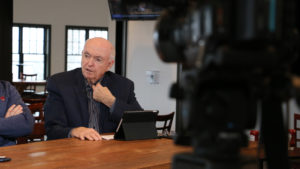
Harry Donahue hosts the longest running show in the history of NBC Sports Philadelphia
Harry Donahue was sitting at the bar at a State College hotel in September 2016, nursing a beer, when a surprising thing happened to him. A couple of guys recognized him, but that wasn’t the surprising part.
Donahue has been the radio play-by-play voice for Temple football since 1984 and had delivered the day’s sports news for 35 years as an anchor on KYW, and he was in town that weekend to call the Owls’ early-season game against the Nittany Lions. He might have expected to hear a Hey, Harry! from a Temple fan or two who had made the trip to central Pennsylvania. But these two guys at the bar weren’t Temple fans. They were locals, and it was the reason they recognized Donahue that caught his attention and stayed in his memory.
“Hey,” one of them said to him, “You’re the guy who does the golf show.”
Yes, he is, and if you mention “the golf show” to someone from the Philadelphia area, the likelihood is that the two of you have the same program in mind, Inside Golf, which ranks as one of the great success stories in regional television over the last quarter-century. Having aired for the first time on Jan. 1, 1998, Inside Golf is the longest-running show in the history of NBC Sports Philadelphia (or what used to be Comcast SportsNet), the Delaware Valley’s 24-hour sports network. At a time when companies have been grappling with the question of how to survive and thrive in such a fragmented media world, the program has maintained a firm hold on its demographic: golf aficionados in and around Philadelphia—and a few as far as 200 miles away.
“The reach—who’d have thought in Happy Valley you’d get recognized for a golf show on a Penn State football weekend?” said Donahue, who was a frequent panelist on Inside Golf before becoming its host more than a decade ago. “You never know who’s listening or watching or why they’re watching. They’re out there. It’s the silent … minority? I don’t know.”
They’re out there, all right, and they’re loyal. Inside Golf airs four-to-five times a week on NBCSP, though its primary audience is drawn from its slot on Sundays at 10 a.m., and Ken Selinger, the show’s executive producer, estimated that the show reaches 75,000 to 100,000 households each week. It hasn’t changed much since its debut, despite the changes around it, and that consistency has allowed it to stay relevant.
“We usually have people who are passionate about the game, and that really helps,” Selinger said. “You’re not going to watch it and hear ridiculous things that make no sense at all. It looks good on the air. It’s not just slopped together, and people don’t think they’re wasting their time. We keep it fresh.”
That mission is more challenging these days than it was when Selinger began developing the show in 1997. Golf was hot then, an ascending sport. Tiger Woods won his first Masters. Phil Mickelson was on the come, having won the Phoenix Open and the Byron Nelson Classic the year before. Courses were soon popping up all over Philadelphia and its suburbs: Blue Bell Country Club, Turtle Creek in Limerick, Honeybrook Golf Club, others.
Through his company CCI Communications, which he founded in 1982, Selinger had long established himself as a reliable and innovative creator of local sports programming, dating to his years at Philadelphia’s first regional cable channel, PRISM. In the early 1980s, Selinger and Donahue had collaborated on Temple Sports Now, and later in the decade, Selinger delivered a full-fledged hit—and launched the broadcasting career of longtime WIP morning-show host Angelo Cataldi—with The Great Sports Debate, a roundtable-discussion show featuring sportswriters from The Inquirer and The Daily News. With Comcast SportsNet about to hit the airwaves and golf’s popularity surging, the Philadelphia PGA Section approached Selinger, seeking to capitalize on what it perceived to be the perfect time for a regional golf program.
“They wanted to do a show that promoted the local golf professional, not the touring pro,” Selinger said. “So we developed a budget with the section. They owned the show. They controlled the marketing.”
That arrangement didn’t last—at least, not in that form. Hosted originally by Ed Abrams, one of Donahue’s cohorts at KYW, Inside Golf aired first on Saturday nights, then was re-telecast throughout the week. After nine months, the section came back to Selinger. The show hadn’t really taken off yet. On Saturday nights, the program had a problem: Nationally televised tournaments were running into its time slot and siphoning away its audience, and the section was struggling to manage and market the show and to keep costs down.
“They said to us, ‘Do you want to take it over?’” Selinger said.
He knew the show had a format that could work, particularly a regular segment called “Teed Off,” during which local pros and golf writers discussed and debated golf-related issues and news items. To this day, “Teed Off” serves as Inside Golf’s fulcrum, allowing it to hold on to its core audience while making it accessible to casual golf fans.
“You don’t want to gear everything toward just the members of four different private clubs,” said Donahue, the show’s fourth host, succeeding Abrams, Don Cannon, and Ken Adelberger. “I go back to the philosophy of my early days of broadcasting. Your audience is that guy with the six-pack, sitting there in his shorts—maybe even a Sunday morning with a six-pack—and he just wants to hear what’s going on in golf. If you can keep that in mind, you’re going to be fine.”
Striking that balance was the key, Selinger realized. That would keep the show on the air—that, and getting some steady financial backing. At the time, he had 15 people on staff. With the section agreeing to continue contributing to the show, CCI had the infrastructure to take on handling Inside Golf. It found title sponsors: PECO, Firestone, Susquehanna Bank, Golf Tech. Courses paid to have the program profile them, to have seven minutes of a 22-minute episode devoted to their traditions or amenities or latest renovations. It was an opportunity to sell themselves and the game.
For instance, when Martin Emeno, the director of operations for the Golf Association of Philadelphia, was looking three years ago to expand the association’s reach and visibility within the region, a partnership with Inside Golf seemed a natural fit. The program has featured the association in each episode ever since, often with Emeno himself making an appearance, and local pros were eager to participate, too.
“We knew the show was highly respected within the golfing community,” Emeno said. “It offers a nice variety of pieces. They’re not tournament-focused. They do a fair amount of human-interest pieces, and they have dedicated talent who have been around a while. They get talent that is recognizable. The show’s flow is really good. You don’t get bored with it. Some shows have come and gone, but Ken’s show has remained.”
Its staying power has been impressive, considering that the sport hasn’t enjoyed the same cultural penetration that it did when Inside Golf was getting off the ground. Revenue streams dwindled as golf receded in popularity. The staff who work full-time on the show now number three: Selinger, Donahue, and editor-producer Stacey Martin. They handle everything out of CCI’s modest headquarters in a small Malvern office park.
Yet the show keeps going and going with no signs of stopping, one episode a week, steady as a steam train. When Merion hosted the U.S. Open in 2013, Inside Golf did a series of episodes previewing the tournament, and on the program’s YouTube channel, those episodes drew thousands of views, becoming some of the show’s most-watched programming. “All of a sudden,” Martin said, “that buzz starts happening on a global sphere. ‘The U.S. Open is at someplace in Philadelphia this year. Let’s Google ‘U.S. Open.’’ And then you find this little show in Philadelphia that’s showing you Merion on a microscopic level. Somehow that show becomes one of our most viewed because we are representing them from a hometown sense.”
There will be plenty of opportunities in the years to come for the show to provide the same kind of immersive coverage to big events and expand its already-loyal audience. Merion will host the 2022 Curtis Cup Match and the 2026 U.S. Amateur. Trump National Golf Club, in Bedminster, N.J., will host the 2022 PGA Championship, and after hosting the KPMG Women’s PGA Championship this June, Aronimink Golf Club in Newtown Square will be the site for the 2026 men’s tournament. Chances are, as those events get closer on the calendar, people will be watching Inside Golf. For 22 years, they always have. “I don’t think we had an idea of how good the following was until we had a regular spot on it,” Emeno said. “It seemed like wherever I went, I’d hear, ‘Hey, I saw you on Inside Golf. You don’t know how many people are watching the show until people start talking to you about it.” Its host can relate.


